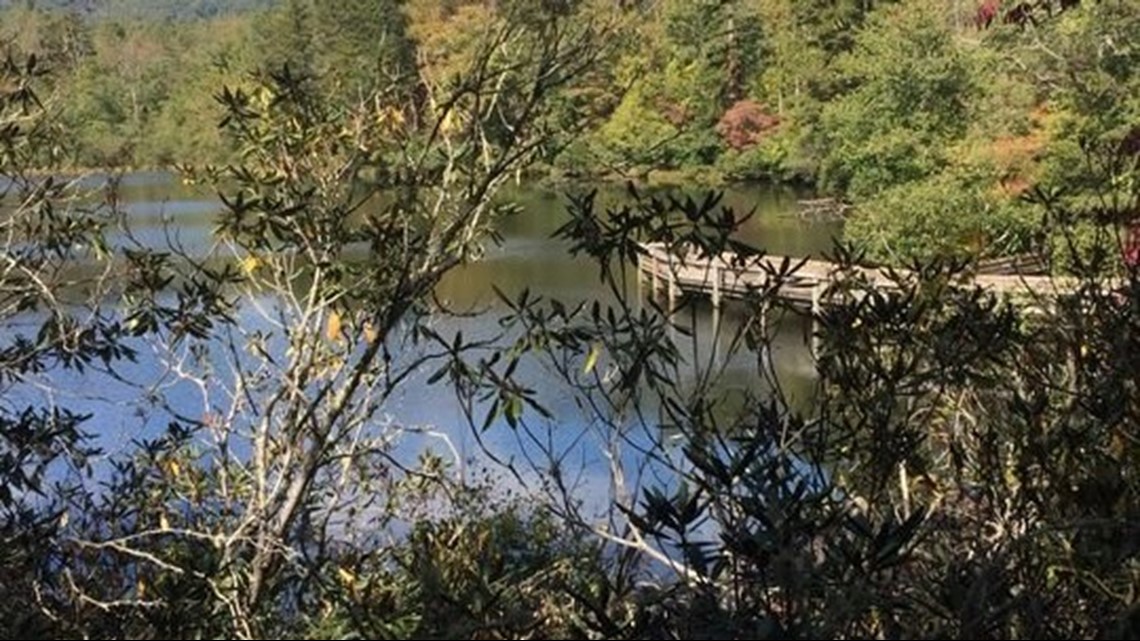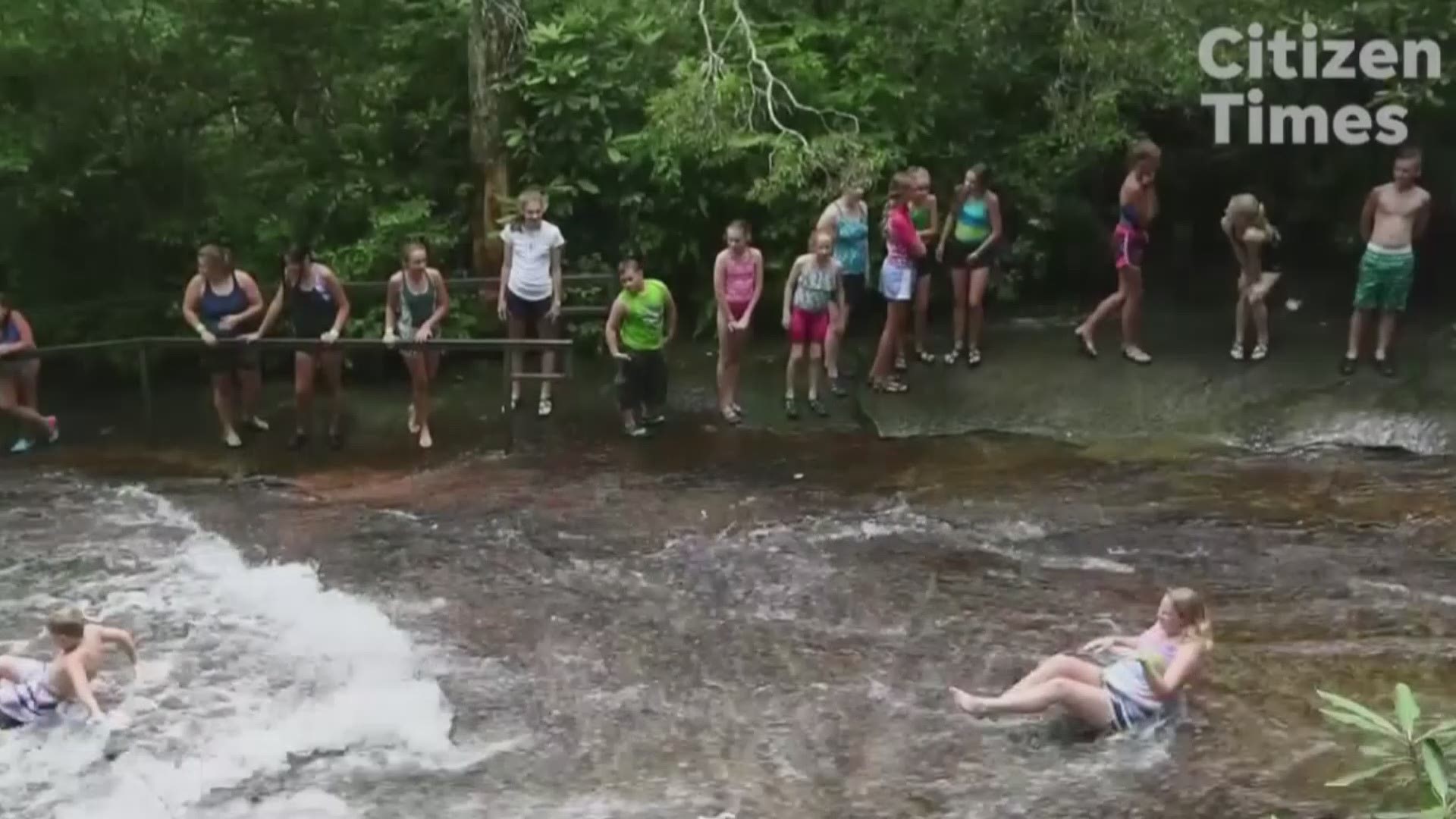PISGAH NATIONAL FOREST - The carefree, summertime pastime of jumping in a forest watering hole for a splash, a cool-down, a thrill and a lasting memory, is quickly getting a slap of reality.
As 2018 is heating up to be another deadly year for those recreating in and around rivers and waterfalls – there have been four waterfall-related deaths so far this year in Western North Carolina, the most recent Saturday at Rainbow Falls in Transylvania County – officials are sounding the alarm that there is nothing safe about a waterfall.
Saying no to waterfall peer pressure could save your life, your dog, your family
“The forest is not Disneyland. We understand it’s great place for people to cool off, but since it’s a natural environment, there are inherent dangers, rapidly rising water, unknown footing, underwater hazards,” said Jeff Owenby, who oversees recreation on the Pisgah District of the Pisgah National Forest, one of the busiest forests in the country.
“They are not managed for swimming. Just because you see someone else in a swimming hole doesn’t mean it’s a safe place,” he said.
Stay clear of some rivers, creeks and waterfalls
But people still want to get wet in the summer.
If you’re looking for a place to take a quick dip in a river or waterfall pool, don’t even think of going to the Blue Ridge Parkway. Spokeswoman Leesa Brandon said there is a blanket “no swimming” policy on any parkway property, which includes any rivers and creeks and waterfalls like Crabtree and Linville.
The Pisgah and Nantahala national forests combined cover more than 1 million acres. Due to the sheer volume of land and watering holes, it would be impossible to erect barricades and signs or staff rangers at every spot that fills with water. So rangers ask for people to heed the signs warning this: “Danger. Death and Serious Injury Have Occurred Here.” They ask visitors to not go past those signs.
And where there’s no sign, they ask people to use common sense and not climb or swim anywhere near a waterfall.
Plenty of places to enjoy the water safely
To aid people in their summertime pursuit of happiness, the U.S. Forest Service maintains designated areas for getting wet with the relative safety of lifeguards, including Sliding Rock near Brevard and Lake Powhatan in Bent Creek Experimental Forest.
But the best way to stay absolutely safe and enjoy a summer splash is at a designated swimming area with clear water, well-defined rules and lifeguards.
Sliding Rock
The granddaddy of WNC watering hole fun, the 60-foot natural rock waterslide is on U.S. 276 in the Davidson River area of Pisgah National Forest. It has been drawing summer splashers since at least the late 1800’s, Owenby said.
“It was called Slippery Shoals by students at the Biltmore Forest School. It’s obviously been an attraction for years, and lifeguards are mentioned in some old district operating plans in the early 1970s,” he said.
The attraction draws about 250,000 people a year between Memorial Day and the end of October.
But it is not a swimming area. Guests are only allowed to slide down into the frigid water, then must climb out quickly or risk getting kicked in the head by the continuing onslaught of sliders.
There are lifeguards at Sliding Rock, which is operated by a new private vendor this year, Pisgah Hospitality Partners. The rate has increased a dollar to $3 per person from May 26-Sept. 3, and weekends thereafter through Oct. 28.
With the new fee come new amenities. Credit and debit cards will now be accepted, there will be snacks, drinks, towels and water shoes available for purchase, fully accessible restrooms, and new signs with area information and health and safety tips. Personal floatation devices will now be available for rent in the parking area but are not required.
There is no alcohol and no picnicking allowed. Visit www.pisgahcampgrounds.com or call 828-885-ROCK.
Davidson River
The river hugs U.S. 276, also known as the Forest Heritage Scenic Byway, which cuts through Pisgah National Forest about 40 minutes southwest of Asheville. If you want a forest-like setting for getting wet, this is it.
The Davidson is a designated Class C Trout stream, meaning it’s clean and cold enough to support a healthy trout population, and swarms of anglers. It’s also considered a class 1 stream, slow-moving and shallow enough for tubing.
Bring your own inner tube or rent one for a small fee at the shops at the entrance to the forest at the intersection of N.C. 280/U.S. 276/U.S. 64, such as Davidson River Tubing and Dolly’s Dairy Bar and Gift Shop.
Put it at any one of several access points along the river including Coontree Picnic Area, Stillwater or the Davidson River Bridge that crosses into the Davidson River Campground – access from the campground is reserved for those camping.
Enjoy a cool, lazy float and take out at the Sycamore Flats Picnic Area, just inside the forest entrance. The distance from Coontree to Sycamore is about 4 miles and depending on water level, can take 45 minutes to float.
Owenby said life jackets for all ages are strongly recommended.
“We can’t say that this is ‘safe.’ There’s always the chance that a tree falls across the river and creates a hazard. It’s never going to be safe in a flood stage,” Owenby said.
Carolina Hemlocks and South Toe campgrounds
Carolina Hemlocks is a popular camping and picnicking area managed by the U.S. Forest Service, sitting on the South Toe River in Yancey County, on N.C. 80 just south of Burnsville near the Blue Ridge Parkway.
The river is about 40-60 feet wide and ranges in depth from 2-10 feet in places, said David McFee, supervisory forester for the Appalachian Ranger District of Pisgah National Forest.
This is not a designated swim area, but rather a place for shallow wading, he said.
“It’s not a lazy river. It’s more like a rapids. The water flow changes often. Watch the weather,” he said, since heavy rain can cause a rapid rise in water levels and bring down debris.
In the Memorial Day storms, the water rose so high it washed away the accessible, 15-foot fishing pier. McFee said it still hasn’t been found.
The nearby South Toe Campground, also on N.C. 80, is managed by Yancey County. There is a day use fee for picnicking and river access and fishing, which also requires a North Carolina fishing license. Bring inner tubes or rent them at Carolina Hemlocks or at South Toe or shops in nearby Burnsville.
For more information, call the Appalachian District office at 828-689-9694 or the Yancey County Chamber of Commerce at 828-682-7413.
Lake Powhatan


The lake is right in the middle of Bent Creek Experimental Forest, mere minutes from downtown Asheville. That makes it one of the busiest swimming spots on the forest, but it is quite lovely, surrounded by 6,000 acres of woods, streams, hiking and mountain biking trails and home to a wide variety of wildlife.
If you can swing a trip on a weekday, it might not be as crowded. A few extra swimming buddies, though, is worth the price — $2 for day use — and an added layer of safety. There are no boats allowed on the lake. There is a designated swim area, and lifeguards.
The water can get warm in summer, but this makes it a great place for kids and those averse to the shocking 60-degree temperatures of many mountain lakes and rivers, like Sliding Rock.
The lake is also open for fishing, with a newly renovated, accessible fishing pier — North Carolina fishing license is required for ages 16 and older. There is a picnic area, showers, flush toilets and campsites with and without hookups.
While enjoying the trees and the lake, however, beware of black bears. The U.S. Forest Service recently issued a warning to visitors that bears have been on the move in Bent Creek. Clean up food waste and store it properly.
Lake Powhatan is at 375 Wesley Branch Road in Bent Creek. For more information, call the gatehouse at 828-667-5627, or Pisgah Hospitality Partners at 877-444-6777 or visit www.pisgahcampgrounds.com.
Swimming hole and waterfall safety tips:
- Never swim or visit a waterfall alone.
- Know how to swim.
- Wear a life jacket.
- Watch children and pets at all times. Anyone, but especially children, can slip underwater easily, and can drown in shallow water.
- Let someone know where you're going and when you plan to return.
- Check the weather before heading out.
- Do not jump off waterfalls or dive into pools.There might be rocks, trees or other hazard beneath the water.
- Follow instructions posted at all waterfalls and trails.
- Stay on developed trails, observation decks and platforms.
- Do not climb on rocks above waist height.
- Do not swim or wade upstream near a waterfall.
- Watch your footing. Dry rocks can be just as slippery as wet ones, especially those covered with algae.
- The top of any waterfall is the most dangerous. Do not lean over a ledge at the top of a falls.
- Make sure you are in a safe, solid location before taking pictures or selfies.
- Bring your cell phone in case you need to call for assistance.

